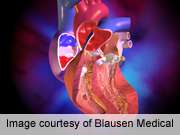For intrauterine growth restricted fetuses, a cardiovascular risk score is highly predictive of infant hypertension and arterial remodeling, according to a study published in the June issue of the American Journal of Obstetrics & Gynecology.
(HealthDay)—For intrauterine growth restricted (IUGR) fetuses, a cardiovascular risk score is highly predictive of infant hypertension and arterial remodeling, according to a study published in the June issue of the American Journal of Obstetrics & Gynecology.
Mónica Cruz-Lemini, M.D., from the University of Barcelona in Spain, and colleagues examined the potential of fetal echocardiography for predicting hypertension and arterial remodeling in 6-month-old IUGR infants. A total of 100 IUGR and 100 control fetuses were observed into infancy. Perinatal Doppler imaging, cardiac morphometry, ejection fraction, cardiac output, isovolumic relaxation time (IVRT), tricuspid annular-plane systolic excursion (TAPSE), and tissue Doppler imaging were conducted.
The researchers found that the strongest predictors for postnatal vascular remodeling were fetal TAPSE, right sphericity index, IVRT, and cerebroplacental ratio. Infant hypertension and arterial remodeling were predicted by a cardiovascular risk score based on fetal TAPSE, cerebroplacental ratio, right sphericity index, and IVRT (area under the curve, 0.87; P < 0.001).
"Fetal echocardiographic parameters identify a high-risk group within the IUGR fetuses who could be targeted for early screening of blood pressure and other cardiovascular risk factors and for promoting healthy diet and physical exercise," the authors write.
More information:
Abstract
Full Text (subscription or payment may be required)
Journal information: American Journal of Obstetrics and Gynecology
Copyright © 2014 HealthDay. All rights reserved.




















